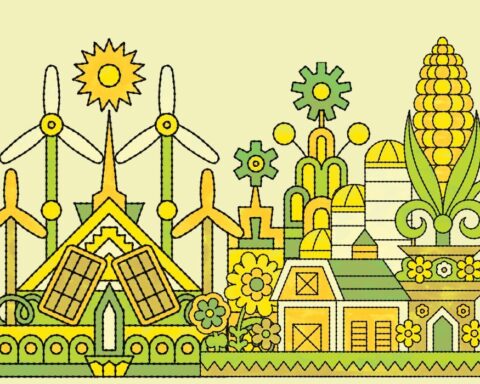Hero: Marks and Spencer
The British department store Marks and Spencer (M&S) announced in late October it has committed to eliminating the use of toxic chemicals throughout its products and supply chain by 2020. An investigation by Greenpeace last summer found that the majority of clothing sold by M&S and other major retailers contained a mix of chemicals harmful to animals and humans. Some chemicals were added intentionally to the textiles to provide a benefit such as wrinkle resistance, while others remained on the clothing as residue from the manufacturing process. The “Detox” campaign that followed successfully pressured M&S into sitting down with Greenpeace, and has led to the company formulating a new set of chemical commitments. Detox campaign coordinator Martin Hojsik is pleased by the company’s newfound dedication, praising M&S in a press release for “showing real leadership on the issue of toxic water pollution.”
M&S has pledged to phase out the use of perfluorocarbons (PFCs) – a group of chemicals used to make clothing water- and stain- resistant – by the end of 2016. PFCs are not processed properly and accumulate in humans and wildlife over time. They have proved toxic for some laboratory animals. With no technical alternatives currently available, M&S will be partnering with universities, dye houses, chemical manufacturers and other industry players in hopes of setting a clear benchmark for the industry. It has also resolved to increase transparency throughout its supply chain, and will launch a chemical discharge disclosure trial at five mills in China to measure groups of hazardous chemicals identified by Greenpeace as potentially harmful to humans and the environment.
Although rising wages in China have resulted in sewing factories moving offshore, the resource-intensive dyeing facilities responsible for most of the chemical use have remained. A group of Chinese NGOs released a report in October emphasizing the need for expanded on-site testing. It found that supply chain management for international clothing companies is much stronger at cut and sew factories compared to the dyeing and finishing facilities. With Chinese water prices low and government environmental enforcement lax, the report concludes that “dyeing and finishing companies commonly skip implementing water or energy savings, make no effort to reduce pollutant discharge and consistently fail to abide by environmental laws.”
Zero: Gruppo Riva
Italian Prime Minister Mario Monti’s cabinet passed an emergency decree in late November allowing Gruppo Riva’s Ilva steel mill in southern Italy to continue operating, overruling a court decision to shut down portions of the plant and seize output over environmental and health problems. Seven senior executives were arrested on November 27 for conspiring with local politicians and officials to downplay the scale of pollution at the site, which Italian magistrates have described as an “environmental disaster.” Emilio Riva, one of the richest men in Italy, was placed under house arrest back in July under suspicion of having coordinated the cover-up as chairman of Grupo Riva. His son Fabio, the chief executive, has likely fled to South America to avoid prosecution. (Update: Fabio was arrested in late January in Britain, and is fighting extradition) A local priest has also been implicated in the growing scandal.
The Italian National Health Service released data in October showing that residents of Taranto – the town that houses the steel mill – are 30 per cent more likely to develop tumors and face elevated risks for various forms of cancer. Prosecutors estimate that 386 deaths have occurred as a result of the emissions released over the past 13 years. The agreement reached between management and the Italian government will require that a $4 billion refurbishment be undertaken to comply with European Union emissions standards by 2016. Production will be allowed to continue throughout this period. Union boss Gianni Venturi blamed the company for failing to make the investments in new technology that its competitors made years ago. “Plants such as the ThyssenKrupp one in Duisburg (Germany) or the Voestalpine one in Linz (Austria) are very similar to Ilva … but [they] have a much more sustainable environmental impact,” he told Reuters in December.
The Ilva complex is the largest European steel mill, responsible for 8 per cent of continental output. It provides about 20,000 jobs in a region facing high unemployment. The national government has been desperate to preserve the facility, concerned that its downfall will lead to the loss of more industrial manufacturing jobs. Four per cent of the country’s GDP is derived from the steel supply chain, impacting industrial heavyweights from Fiat SpA down to smaller manufacturers. The future of the facility is far from assured, with national elections scheduled for February casting uncertainty over the deal that provides €336 million (roughly $440 million) in federal retrofit funds.
Click here to view our complete Heroes & Zeros series.







